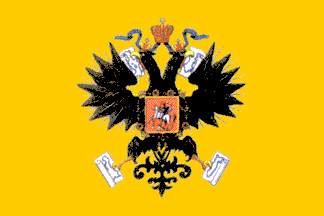 image by Arnaud Palac and António Martins, 12 Dec 1999
image by Arnaud Palac and António Martins, 12 Dec 1999
Last modified: 2023-08-05 by valentin poposki
Keywords: tzar | royal flag | aleksandrina | moscow | eagle: double headed (black) | sword | wreath | shield | ivan 4 “the terrible” (russia) | star: 8 points | stars: 5 (8 points) | crosses: 2 | cross: coupe |
Links: FOTW homepage |
search |
disclaimer and copyright |
write us |
mirrors
On this page:
 image by Arnaud Palac and António Martins, 12 Dec 1999
image by Arnaud Palac and António Martins, 12 Dec 1999
This is the personal Standard of the Tsar.
Jaume Ollé, 21 Jul 1998
Golden flag with black coat of arms with four scrolls: Vessel standard (1699-1917)
Željko Heimer, 03 Apr 1999, quoting from Flag-znamya korablya, Russian Navy website, consulted 07 Mar 1999
Only one Emperor’s Standard (yellow with black eagle with maps in his claws) existed in times of Catherine the Great. She used it. Kostroma (city on Volga River) have the arms: «Azure, a ship of Catherine the Great with Emperor’s Standard on main-mast».
Victor Lomantsov, 02 Jun 2000

image by Arnaud Palac and Victor Lomantsov, 30 May 2000
Broad-pennant of Emperor — swallow-tailed, emperor’s standard at the hoist, white at the fly.
Victor Lomantsov, 30 May 2000
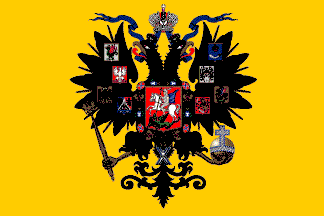 image by Mario Fabretto, and António Martins, 14 Dec 1999
image by Mario Fabretto, and António Martins, 14 Dec 1999
This is the Russian Emperor Standard. It should had been
adopted toward 1858 and this is the version used ashore.
Mario Fabretto, 17 Jul 1998
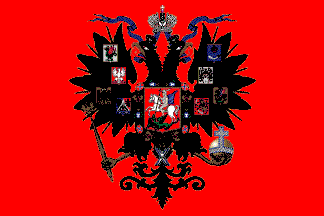 image by Mario Fabretto, and António Martins, 14 Dec 1999
image by Mario Fabretto, and António Martins, 14 Dec 1999
The Tsar’s standard afloat is the same as ashore but with red background.
Jaume Ollé, 21 Jul 1998
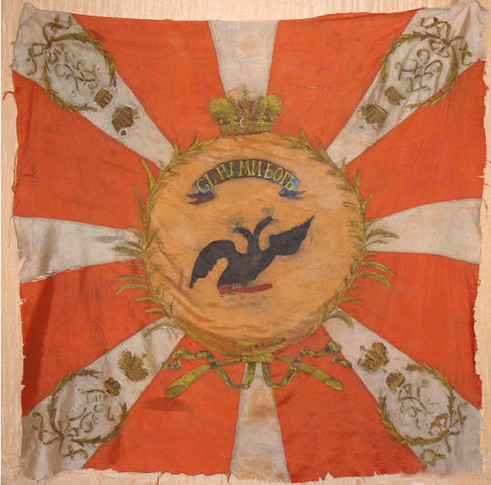 image located by William Garrison, 03 January 2013
image located by William Garrison, 03 January 2013
Russian Imperial Army Regimental "Color" Banner of One of the Life-Guards' Regiments From the Reign of Pavel I, Circa 1800. (source)
Description:
The silk banner roughly square, the center with the Imperial double-headed eagle in semi-profile with one raised wing and one
lowered wing and with lightning bolts in its talons, set within ribbon tied laurel wreaths beneath the devices "God is with us" and "Bliss" and surmounted by the Imperial crown, the corners with the mirror Russian/Maltese monograms, also within ribbon-tied laurel wreaths. Measurements: 56 ½ x 57 ½ in.; 144 x 146 cm
In 1797, Emperor Paul I instituted a large scale reform of the Russian army and government that had important implications for Russian heraldry and military regalia. Among these changes was the institution of new types of banners for military regiments. Every Life-Guards' Regiment received one "White" and several "Color" banners of new design. The Russian / Maltese monogram was added and the image of the Imperial eagle was radically changed to closely resemble that of the Prussian Army. This banner could have belonged to any of the three Life-Guards' Regiments existent during the reign of Paul I: the Preobrazhensky, Semyonovsky, or Izmailovsky, since all Life-Guards' Regiments received the same type of banner, differentiated only by the colors of their poles. Prior to Paul I's accession to the throne, each new Russian monarch would discard the army's existing regalia in order to substitute designs pleasing to the new ruler. Paul definitively changed this rule, declaring that all flags and banners were to remain in service indefinitely. It is therefore possible that the offered lot was in use well after Paul's assassination in 1801, and even during the battles of the Napoleonic Wars of 1805-1814.
On this design, see A.V. Viskovatov, Istoricheskoe opisanie odezhdy i vooruzheniia rossiiskikh voisk, vol. 9, St. Petersburg, 1841-1862, ill. 1257 and V.V. Zvegintsov, Znamena i Shtandarty Russkoi Armii, Paris, 1964, p. 25.
William Garrison, 03 January 2013
Looking like original banner of 1800... In 1800 this type of banners was granted to 3 regiments. Full amount of banners - 47: 19 - to Life-Guard Preobrazhensky Regiment, 14 - to Life-Guard Semenovsky Regiment, 14 - to Life-Guard Izmailovsky Regiment.
Victor Lomantsov, 04 January 2013
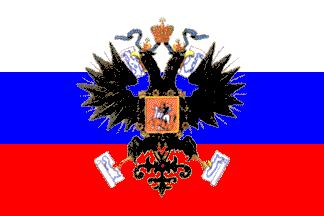
image by Arnaud Palac and António Martins, 12 Dec 1999
The Tsar’s standard in Moscow is the same as the normal one but
white, blue, red horizontal stripes background.
Jaume Ollé, 21 Jul 1998
I’m not so sure it is the one. The eagle should be yellow and not black with maps (“naval version”).
Russian tricolour with golden coat of arms allover: The first vessel standard "Moscow Tsar Flag" (1693-1699).
Željko Heimer, 03 Apr 1999, summarizing from
Flag-znamya korablya,
Russian Navy website, consulted 07 Mar 1999
Symbolism of Andreevsky Flag was also Peter’s contribution to his father — tsar Alexei Mikhailovich who instituted the special flag - dark red two-headed eagle on white-blue-red cloth — for the first
military Russian vessel — three-mast galiot Eagle.
Edward Mooney, 14 Mar 1999, quoting from Russian Navy website
In one of the worlds first flagbooks, compiled by Carel Allard (from Amsterdam) in 1695 [ala95], shows three Russian flags:
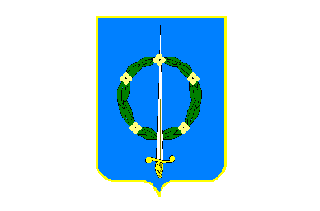 image by Victor Lomantsov, 20 Jul 2000
image by Victor Lomantsov, 20 Jul 2000
Also exists a Tsar Standard (and pennant) for his rural house of Alexandrina: white with emblem (white bordered black shield, vertical sword, ring of wreath).
Jaume Ollé, 21 Jul 1998
Flag for “The Alexandria”, a personal summer-cottage of Emperor. White flag with arms: Azure, a Sword in pale Argent hilted Or and decored with a round Wreath of flowers and leaves.
Victor Lomantsov, 20 Jul 2000

image by Victor Lomantsov, 20 Jul 2000
Broad-pennant for “The Alexandria”, a personal summer-cottage of Emperor. The same design
but swallow-tailed and long.
Victor Lomantsov, 20 Jul 2000
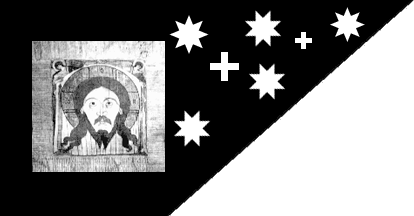
image by António Martins, 22 Jan 2003,
from The Cultural Atlas of Russia
I have book called The Cultural Atlas of Russia which shows a flag of Ivan VI which is called the flag at Kazan.
Steve Stringfellow, 23 and 27 Aug 1999
It is a dark top heavy trapezoid, with the refered icon painted on the hoist part and a roughly regular arrangement of light five stars and two couped crosses on the tappering fly. As said, the now faded colors are disputed (it is a black-and-white photo).
António Martins, 21 Jan 2003
This flag is totally different than the one in Smith’s 1975 big book [smi75c]. So, the question is: what flag did Ivan IV have?
Steve Stringfellow, 23 and 27 Aug 1999
I confess that I have no idea: Ivan the terrible was the first Muscovy prince to use the title of Tsar
(from latin "CAESAR", in Russian "carh | царь"), after getting rid of Mongol / Tatar domination and having submitted to his own personal power the other Russian princes
(Tver, Kiev, Novgorod, etc.) — hence «Tsar
of all Russias». This happend in a historical period when heraldry wasn’t yet really set in Russia (it come somewhat
later, after Italian, German and French influences), and I guess that Ivan’s flag would have much more to do with Mongol Khan’s regalia, than to the usual symbols of a westerner monarch. This image seems to confirm it.
António Martins, 24 Aug 1999
Ivan IV, the Terrible (1530-1584), often considered as the founder of the modern Russian Empire. He was the first to adopt the title of czar (from Latin Caesar, since Moscow was supposed to be the third Rome — replacing Rome and Byzance) and increased the Russian territory by conquering the Khanates of Kazan and Astrakhan.
Ivan Sache, 01 Oct 2000